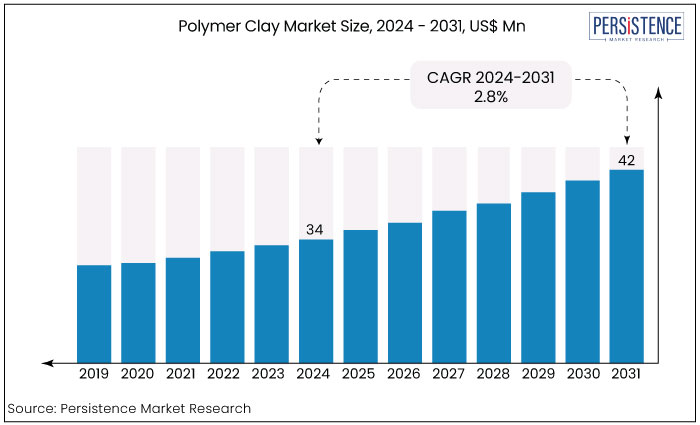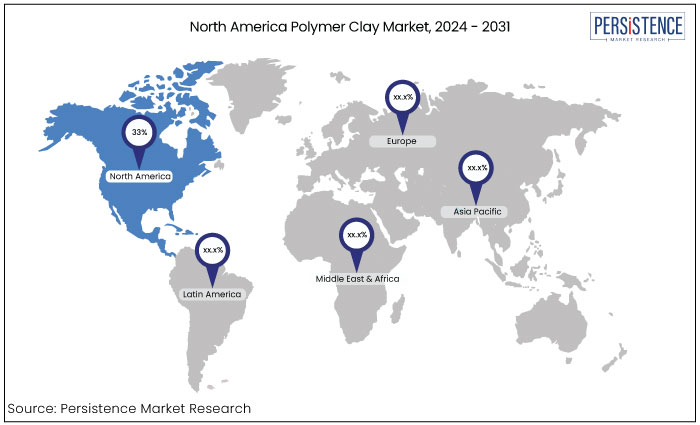Industry: Chemicals and Materials
Published Date: September-2024
Format: PPT*, PDF, EXCEL
Delivery Timelines: Contact Sales
Number of Pages: 177
Report ID: PMRREP29383
The polymer clay market is estimated to increase from US$34 Mn in 2024 to US$42 Mn by 2031. The market is projected to record a CAGR of 2.8% during the forecast period from 2024 to 2031. The increased use of polymer clay in schools and art programs promotes its widespread adoption among students and educators, which eventually leads the market forward. North America is seen as the rapidly growing and dominating region globally in terms of revenue generated from the market.

Key Highlights of the Market
|
Market Attributes |
Key Insights |
|
Polymer Clay Market Size (2024E) |
US$34 Mn |
|
Projected Market Value (2031F) |
US$42 Mn |
|
Global Market Growth Rate (CAGR 2024 to 2031) |
2.8% |
|
Historical Market Growth Rate (CAGR 2019 to 2023) |
2.2% |
|
Region |
Market Share in 2024 |
|
North America |
33% |
North America, particularly the United States has a well-established craft and DIY culture. Polymer clay is widely used for various creative projects including jewellery making, sculptures, and home decor. The popularity of these activities drives significant demand for polymer clay products.
A large and diverse consumer base including hobbyists, professional artists, and craft enthusiasts, fuels the market. The prevalence of craft fairs, workshops, and online communities dedicated to polymer clay further supports this demand.
The region benefits from a robust network of craft stores and online retailers specializing in polymer clay. Major craft store chains like Michaels and Hobby Lobby and online platforms like Amazon and Etsy provide easy access to a wide range of polymer clay products.
The developed infrastructure for both retail and distribution ensures that polymer clay products are readily available to consumers supporting market dominance. North America is a hub for innovation in the polymer clay market.
Many manufacturers and suppliers based in the region continuously develop new products, including unique colours, textures, and finishes catering to evolving consumer preferences. The region sees trends such as customization and personalization in polymer clay products driven by creative DIY enthusiasts. This constant innovation keeps the market dynamic and competitive.
High disposable income levels in North America allow consumers to spend on hobbies and craft supplies, including polymer clay. This economic factor contributes to the region’s leading market position.

|
Category |
Market Share in 2024 |
|
Product Form - Solid |
60% |
Based on product form, the market for polymer clay is divided into solid and liquid. Among these, the solid form segment dominates the market accounting for 60% of the total market share. Solid polymer clay is highly versatile and used for various applications, including jewellery making, sculpting, home décor, and craft projects. Its moldability and ease of shaping make it a preferred choice among artists and hobbyists.
Solid polymer clay is user-friendly allowing consumers to easily shape, sculpt, and bake it to create durable and customized items. This ease of use contributes significantly to its dominance in the market.
The market for solid polymer clay is well-developed with a wide range of colors, textures, and finishes available. Leading brands like Sculpey, Fimo, and Premo offer various solid polymer clay products catering to diverse consumer needs.
Most consumers prefer the solid form due to its practicality and the extensive range of creative possibilities it offers. The ability to bake solid polymer clay at home makes it convenient for both amateur and professional users.
|
Category |
Market Share in 2024 |
|
End Use - Residential |
38% |
The market is classified into residential, commercial and industrial based on end use. Among these, the residential segment dominates the market. The growth of e-commerce platforms is significantly contributing to the increasing utilization of polymer clay in domestic environments.
The utilization of polymer clay in domestic environments is motivated by its availability, cost-effectiveness, and adaptability. Its user-friendliness renders it appropriate for both novices and seasoned artisans. Polymer clay is resilient and provides customization possibilities that facilitate distinctive designs. It offers therapeutic and educational advantages and is suitable for recreational pursuits.
Polymer clay is a synthetic clay composed of the polymer polyvinyl chloride (PVC). It is utilized to solidify items. A liquid is introduced to dry particles to bestow qualities akin to those of mineral clay as polymer clay generally lacks clay minerals.
Baking the component leads to solidification hence its informal designation as clay. Polymer clay is frequently utilized in arts and crafts as well as in commercial applications to produce decorative components. Numerous esteemed museums display artworks made from polymer clay hence maintaining chances for market participants.
Polymer clay had significantly evolved since its inception in the late 1930s when it aimed to mitigate wartime material shortages for doll production. Natural clay, composed of water and soil, has been a universally recognized material. In contrast, synthetic modelling substances like polymer clay have been meticulously created as an optimal medium for artistic endeavours.
Due to the material's significant appeal among students, clay enthusiasts, and artists, polymer clay makers began to modify traditional formulations, broaden their product range, and explore the potential in various end-use sectors. Currently, numerous brands of polymer clay undergo specific testing and certification as 'non-toxic' creative materials.
The polymer clay market has experienced steady growth during the period from 2019 to 2023, driven by rising interest in arts, crafts, and DIY activities. Prior to 2023, the market expanded due to the increasing popularity of polymer clay among hobbyists, artists, and educators.
The versatility of polymer clay, which allows users to create custom jewelry, sculptures, and decorative items has been a significant factor in its demand. Leading brands such as Sculpey, Fimo, and Premo have dominated the market with a wide range of colors and textures further driving consumer interest.
The market is expected to continue its upward trajectory post-2024. Growth will be fueled by several factors, including the rising popularity of DIY culture, the increasing use of polymer clay in educational settings, and the expansion of e-commerce platforms making products more accessible.
Innovations in eco-friendly and non-toxic polymer clays are anticipated to attract environmentally-conscious consumers. The market is also poised for growth in emerging regions where artistic activities are gaining traction.
Growing DIY and Crafting Culture
One of the primary drivers for the polymer clay market is the significantly expanding DIY (Do-It-Yourself) and crafting culture globally. As consumers increasingly seek out personalized, handmade, and unique items, polymer clay offers an affordable and versatile medium for creative expression.
The rise of online platforms like Etsy, Pinterest, and YouTube has further fueled this trend by providing a space for artists, hobbyists, and crafters to share ideas, tutorials, and finished products. With polymer clay, users can create custom jewelry, sculptures, and home décor items catering to various tastes and styles.
The demand for creative materials like polymer clay is growing with this cultural shift driving market expansion. Additionally, consumers, particularly millennials and Gen Z are drawn to activities that provide a break from digital interactions finding joy in tangible, and hands-on hobbies.
The continued rise of crafting communities and in-person and online workshops ensures that the demand for polymer clay remains robust positioning this as a critical driver for market growth.
E-Commerce Expansion and Accessibility
The rapid expansion of e-commerce platforms has significantly boosted the global polymer clay market. E-commerce giants like Amazon, Etsy, and specialty craft retailers have made polymer clay more accessible to a broader audience, from professional artists to casual hobbyists.
With the rise of online retail, consumers now have easy access to a wide range of polymer clay products, colours, and tools encouraging more purchases and experimentation with the material. The online retail model also provides access to niche brands and innovative products that may not be available through traditional brick-and-mortar stores enabling small companies to reach a global customer base.
In addition to selling finished goods, platforms like Etsy have created communities where artists share tutorials, kits, and crafting tips, further driving interest and demand for polymer clay. As more consumers shift toward online shopping due to convenience and variety, the market for polymer clay is expected to continue growing particularly as e-commerce platforms expand their reach into emerging markets.
Environmental Concerns and Regulatory Challenges
One significant restraint for the polymer clay market is growing environmental concerns regarding the use of synthetic materials. Polymer clay is primarily made from polyvinyl chloride (PVC), a type of plastic, which raises issues around its environmental impact, particularly in terms of biodegradability and sustainability.
As consumers become more environmentally conscious, there is increasing scrutiny of products derived from plastic, including polymer clay. Regulatory pressures, particularly in regions with stringent environmental laws, could also limit market growth. For instance, restrictions on PVC production and the disposal of non-biodegradable materials may discourage both manufacturers and consumers from using polymer clay.
The rise of eco-friendly crafting materials, such as natural clays or plant-based alternatives, presents competition that could impact the polymer clay market’s long-term expansion. Without significant innovation toward more sustainable formulations, these environmental and regulatory challenges may slow market growth.
Development of Eco-Friendly Polymer Clay
One of the most transformative opportunities for the polymer clay market lies in developing eco-friendly and sustainable alternatives to traditional PVC-based polymer clay. As environmental awareness continues to rise globally, consumers increasingly seek to craft materials that align with their sustainability and low environmental impact values.
Manufacturers that can create biodegradable or plant-based polymer clay will tap into a growing market of eco-conscious crafters and artists. Such products would reduce the environmental footprint of polymer clay and appeal to regulatory bodies that are imposing stricter environmental laws. This innovation could open new avenues in established and emerging markets potentially expanding the customer base to include those who have previously avoided synthetic materials.
By addressing the sustainability concern, manufacturers can position themselves as leaders in a niche market, attracting hobbyists and professional artists who prioritize environmental responsibility.
The competitive landscape of the polymer clay market is characterized by a few leading players, including brands like Sculpey, Fimo, and Premo, which dominate the market with a wide range of high-quality products. These companies focus on product innovation, offering various colors, textures, and finishes to cater to diverse customer needs.
Smaller, niche players also exist primarily targeting specific segments like professional artists or eco-conscious consumers. The market is highly competitive with companies leveraging both traditional retail and e-commerce platforms to expand their reach.
Strategic partnerships with craft stores, online tutorials, and growing DIY communities are key tactics to maintain market share with a focus on customer engagement and innovation driving competitiveness.
Recent Industry Developments in the Polymer Clay Market
|
Attributes |
Details |
|
Forecast Period |
2024 to 2031 |
|
Historical Data Available for |
2019 to 2023 |
|
Market Analysis |
US$ Billion for Value |
|
Key Regions Covered |
|
|
Key Market Segments Covered |
|
|
Key Companies Profiled in the Report |
|
|
Report Coverage |
|
|
Customization & Pricing |
Available upon request |
By Product Form
By Application
By End Use
By Region
To know more about delivery timeline for this report Contact Sales

The polymer clay market is estimated to be valued at US$42 Bn by 2031.
The market is projected to exhibit a CAGR of of 2.8% over the forecast period.
Some of the key players in the market are American art clay co, Inc., Craft polymers., and Kato polyclay.
Growing DIY and crafting culture drives the market forward.
North America is the dominant regional market for polymer clay.